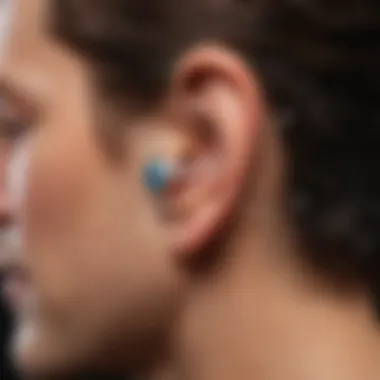Exploring TENS Ear Stimulation in Pain Management


Intro
Transcutaneous Electrical Nerve Stimulation (TENS) has emerged as a significant area of interest in the field of pain management and neurological rehabilitation. Recent developments point to its application via auricular stimulation, igniting discussions among medical professionals and researchers regarding its mechanisms, efficacy, and potential therapeutic benefits. This article delves into TENS ear stimulation, unraveling intricate physiological processes and exploring its relevance across various medical contexts.
Incorporating TENS into clinical practice represents a shift towards non-invasive treatment modalities. By targeting the auricular areas of the ear, the TENS method aligns with the principles of neuromodulation, engaging the body's inherent pain-relieving mechanisms. As the body of research grows, understanding the scientific foundations and effective applications of this technology becomes crucial.
This exploration will encompass key findings, methodological aspects, and future implications for TENS ear stimulation in mitigating pain and enhancing rehabilitation outcomes.
Research Highlights
Key Findings
The study of TENS ear stimulation has unveiled several noteworthy findings:
- Neurological pathways: TENS affects specific nerve pathways, leading to alterations in pain perception.
- Clinical efficacy: Research indicates that TENS can reduce chronic pain symptoms, especially in conditions like fibromyalgia and neuropathic pain.
- Neuroplasticity: Using TENS in neurological rehabilitation has shown potential in promoting neuroplastic changes in the brain, which is vital for recovery processes.
"TENS ear stimulation emerges as a promising adjunct therapy in diverse clinical settings, necessitating further investigation to optimize its application."
Implications and Applications
The implications of TENS ear stimulation are vast, extending across multiple medical fields. The potential applications include:
- Chronic pain management: Suitable for patients seeking alternatives to medications.
- Neurological recovery: Aiding rehabilitation after strokes or injuries.
- Sensory modulation: Addressing conditions like anxiety and depression through novel approaches.
Overall, the increasing interest in TENS ear stimulation corroborates its potential role in transforming patient care approaches.
Methodology Overview
Research Design
A mixed-methods approach is common in research involving TENS ear stimulation, encompassing both qualitative and quantitative methodologies. Randomized controlled trials (RCTs) often provide a robust framework for assessing its clinical effectiveness and evaluating patient outcomes. This design enables researchers to draw reliable conclusions about the impact of TENS on pain relief and rehabilitation.
Experimental Procedures
The experimental procedures typically follow a structured protocol:
- Participant selection: Candidates are usually selected based on specific inclusion criteria, focusing on those suffering from chronic pain or undergoing rehabilitation.
- TENS application: Electrodes are strategically placed on the auricle to target relevant nerve pathways effectively.
- Outcome measures: Researchers monitor pain levels through validated scales alongside functional assessment tools to evaluate improvements.
By adopting rigorous methods, studies can provide valuable insights into the effectiveness and nuances of TENS ear stimulation.
Prolusion to TENS Ear Stimulation
TENS ear stimulation has gained attention as a valuable method in the realm of pain management and neurological therapy. Its significance lies in its potential to alter sensory experiences and pain perception through electrical impulses. This can open more avenues for treatment as we search for alternatives to traditional pharmacological methods. TENS, or Transcutaneous Electrical Nerve Stimulation, uses low-voltage electrical currents to target specific nerve pathways, often applied to the ear.
Understanding TENS Therapy
Transcutaneous Electrical Nerve Stimulation involves delivering electrical impulses through the skin to stimulate sensory nerves. This therapy is fundamentally rooted in the concept that electrical stimulation can influence pain signals traveling to the brain. By adjusting the frequency and intensity of the electrical impulses, TENS therapy aims to disrupt the pain signaling pathway. The method can be initiated using portable devices, making it increasingly accessible for both home and clinical use.
TENS therapy typically engages the gate control theory of pain, which posits that non-painful input can suppress painful input. This principle underlines much of TENS’s functionality, where electrical impulses may mask pain signals, providing psychological relief and potentially decreasing the need for medication. The adaptability of TENS allows it to be used in diverse therapeutic settings, from post-operative care to chronic pain management.
Historical Context of Ear Stimulation


The history of ear stimulation is quite fascinating. In traditional Chinese medicine, auricular acupuncture has been used for centuries. This ancient practice treats various ailments by targeting specific points on the ear. Over time, the modern understanding of these treatment methods began to converge with neurological research.
The innovation of TENS therapy in the late 20th century provided a scientific grounding to practices that had previously relied on anecdotal evidence. Researchers and clinicians began to investigate the efficacy of electrical stimulation at ear points. The rise of ear stimulation techniques integrated into TENS applications has since shown promise in addressing pain, stress, and many neurological conditions.
Understanding this historical context enhances comprehension of the evolution of pain treatment modalities. It also highlights how ancient practices can inform modern approaches, culminating in a field that balances both traditional and contemporary wisdom.
"The evolution of TENS ear stimulation reflects a confluence of ancient knowledge and modern scientific inquiry."
As TENS continues to advance, its role in the broader context of therapy and rehabilitation becomes increasingly relevant. With ongoing studies examining the physiological mechanisms and practical applications, researchers remain optimistic about its future potential in improving patient outcomes.
Physiological Mechanisms of TENS
In the context of TENS ear stimulation, understanding the physiological mechanisms is crucial. This section delves into the underlying processes that TENS therapy influences, shedding light on its potential benefits for pain management and rehabilitation. By exploring how this technique works at a physiological level, practitioners can better appreciate its applications in clinical settings, as well as its limitations.
Neuroanatomy of the Ear
The neuroanatomy of the ear encompasses various structures that play significant roles in auditory processing and sensory perception. Auricular structures, such as the external ear and the associated nerve pathways, are essential in TENS therapy.
The auricle, or pinna, contains a complex network of nerves, including branches of the vagus nerve and the trigeminal nerve. These nerves are involved in numerous bodily functions, including heart rate control and pain perception.
Understanding the anatomy helps clinicians target specific locations for TENS application, optimizing the effectiveness of the treatment. The rich nerve supply in the ear region can enhance the overall experience of pain relief, highlighting the importance of precise stimulation to yield the desired outcomes in patients.
How TENS Affects Nerve Pathways
TENS utilizes electrical stimulation to affect nerve pathways, impacting both sensory and motor functions. The electrical impulses generated during TENS modulate the transmission of pain signals from peripheral nerves to the central nervous system.
When applied to the ear, these impulses can inhibit pain signals and activate descending inhibitory pathways, effectively reducing the perception of pain. This mechanism is essential for managing conditions such as chronic pain, where traditional treatment methods may fall short.
Moreover, TENS aims to restore balance within the nervous system by increasing the flow of nerve impulses, promoting overall well-being. This technique also offers a non-invasive option for patients, which can be beneficial in cases where more aggressive treatments are not suitable.
Endorphins and Pain Modulation
Endorphins are natural pain-relieving compounds produced by the body. They act on the same neural pathways as opioids to reduce pain perception. TENS is known to stimulate the release of endorphins, enhancing the body's capability to manage pain effectively.
The relationship between TENS and endorphin release underscores its viability as a therapeutic option in pain management. By promoting endorphin activity, TENS not only alleviates pain but may also contribute to improving overall emotional well-being.
In understanding this dynamic, professionals can leverage TENS as a complementary approach in comprehensive pain management strategies.
Key Takeaway: The physiological mechanisms of TENS highlight its multifaceted role in influencing pain pathways, making it an important tool in both clinical and therapeutic settings.
Applications of TENS Ear Stimulation
Understanding the applications of TENS ear stimulation is crucial because it highlights the diverse therapeutic potentials of this non-invasive approach. As Transcutaneous Electrical Nerve Stimulation gains traction, its implications extend beyond traditional pain relief into various fields of neurological rehabilitation and stress management. This section elucidates how TENS ear stimulation is applied in different contexts, underscoring its significance in both clinical and personal health frameworks.
Pain Management Strategies
TENS ear stimulation serves as a valuable adjunct in pain management strategies. Its application often focuses on conditions like chronic pain, migraines, and neuropathic pain. The basic mechanism involves the electrical stimulation of nerves in the ear. This stimulation may activate endogenous opioids, hence modulating pain perception. Further, patients report varying results, often influenced by the intensity and duration of stimulation.
- Chronic pain: Many individuals suffering from conditions like fibromyalgia or arthritis have found relief through this approach, possibly due to the direct effects TENS has on pain pathways.
- Acute pain: Some studies indicate that TENS may assist during acute pain episodes, such as following surgery. Immediate application can mitigate discomfort significantly.
- Cost-effectiveness: Compared to pharmacological treatments, TENS devices are often more affordable in the long run, minimizing the overall financial burden on the healthcare system.
This multifaceted use in pain management underscores the need for health care providers to consider TENS ear stimulation as a viable option.
Neurological Rehabilitation
In neurological rehabilitation, TENS ear stimulation can facilitate recovery from various conditions. Patients recovering from stroke, traumatic brain injury, or peripheral nerve injuries may benefit from this method, as it can encourage nerve repair and reduce symptoms like spasticity.
Applying TENS to specific auricular points may influence brain function and enhance rehabilitation efforts. Patients often experience improved limb functionality and decreased pain, thus motivating further rehabilitation efforts. The following points highlight key aspects of its application:


- Targeted Nerve Activation: TENS can stimulate specific pathways beneficial in recovery phases.
- Neuroplasticity Contributions: Evidence suggests that TENS may promote neuroplasticity. This concept refers to the brain's ability to reorganize itself, which is essential in rehabilitation.
- Holistic Treatment Approach: Since TENS has minimal side effects, it can be integrated into comprehensive treatment programs with physical therapy and occupational therapy.
The correct integration of TENS ear stimulation in rehabilitation underscores its potential to enhance recovery outcomes.
Stress Reduction and Relaxation Techniques
Stress management is increasingly recognized as an important component of overall health, especially in today’s fast-paced world. TENS ear stimulation can contribute positively to stress reduction and relaxation. The following points summarize its effectiveness:
- Calming Effect: Many users report a calming effect post-session, which can be attributed to the release of endorphins prompted by TENS.
- Minimized Anxiety Symptoms: TENS may help alleviate symptoms of anxiety, making it a potential tool for those experiencing stress-related disorders.
- Accessibility and Ease of Use: Users can utilize TENS devices at home, making it a convenient option for stress management practices.
Clinical Efficacy of TENS Ear Stimulation
The clinical efficacy of TENS ear stimulation represents a critical facet in the exploration of this therapeutic modality. It speaks to the real-world effectiveness of this approach in alleviating pain and facilitating neurological rehabilitation. This section examines recent studies, patient outcomes, and various factors that contribute to the overall impact of TENS therapy.
Review of Recent Studies
Recent research provides a solid foundation for understanding the efficacy of TENS ear stimulation. Clinical trials and meta-analyses have demonstrated that TENS can significantly reduce pain levels in various conditions.
- Chronic Pain Conditions: Studies show that TENS therapy can serve as an effective intervention for chronic pain diseases like fibromyalgia and osteoarthritis.
- Postoperative Pain Management: In surgical settings, patients receiving TENS showed improved recovery and lower pain scores compared to those who did not receive electrical stimulation.
- Migraine and Tension-Type Headaches: Some studies indicate that TENS may help in reducing the frequency and intensity of migraine attacks.
Furthermore, various studies emphasize the need for personalization in treatment parameters such as frequency and intensity settings, which can lead to more favorable outcomes. Each study highlights the importance of a methodical approach in assessing the effects of TENS on pain reduction.
Patient Outcomes and Satisfaction
Patient outcomes related to TENS ear stimulation are generally positive, marking a notable aspect of its clinical efficacy. Many individuals report a high level of satisfaction with the treatment, resulting from its non-invasive nature and ease of use.
- Improvement in Quality of Life: Patients frequently experience enhanced overall well-being as pain levels decrease.
- User-Friendly Experience: TENS devices often come with straightforward instructions, making them accessible for self-management at home.
- Minimal Side Effects: Unlike pharmacological approaches, TENS therapy typically has fewer adverse effects, allowing for a safer profile in long-term use.
"The integration of TENS ear stimulation into treatment regimens has the potential to greatly enhance patient satisfaction and outcomes."
Advantages and Limitations of TENS
Understanding the advantages and limitations of TENS therapy is critical in evaluating its role in clinical practice. Transcutaneous Electrical Nerve Stimulation, particularly when applied to the ear, can present distinct benefits along with certain considerations. The nuances of these aspects influence decision-making for both practitioners and patients, making it essential to discuss them thoroughly.
Benefits of TENS Therapy
TENS therapy involves the application of electrical impulses through the skin, targeting nerve pathways. This method has grown in popularity due to its non-invasive nature. Here are some key advantages:
- Pain Relief: One of the main benefits of TENS therapy is its ability to alleviate pain. Many patients report significant reductions in pain levels following treatment. This is particularly beneficial when considering conditions such as chronic pain or post-operative discomfort.
- Non-invasive Option: Unlike surgical interventions or certain pharmaceuticals, TENS does not require any invasive procedures. This makes it an appealing choice for those seeking alternative methods of pain management.
- Portable and Convenient: TENS devices are often small and easy to transport. Patients can use them at home or on the go, accommodating their lifestyle without needing extensive clinical visits.
- Customizable Treatment: TENS therapy can be tailored to meet individual needs. Practitioners can adjust intensity and duration based on the patient's pain level and specific condition.
"The multifaceted nature of TENS therapy positions it as a promising tool in pain management strategies."
Potential Side Effects
While TENS therapy has many positive attributes, it is important to also consider its potential side effects and limitations. Awareness of these can help practitioners provide comprehensive care.
- Skin Irritation: Prolonged use of electrodes on the skin can lead to irritation or allergic reactions in some individuals. Proper skin care and monitoring are essential to mitigate these effects.
- Variable Efficacy: The effectiveness of TENS can vary greatly between individuals. Some patients may experience significant relief, while others may find it less effective. Factors like skin tone, nerve sensitivity, and type of pain can influence outcomes.
- Not Universally Applicable: TENS may not be suitable for everyone. Certain conditions, such as those involving implanted devices or certain medical disorders, may restrict its use. A thorough patient history is crucial.
- Mental Perception of Pain: The psychological aspect of pain perception can also affect treatment outcomes. If individuals do not believe in the efficacy of TENS, they might not experience the expected benefits.
Understanding these advantages and limitations sets the foundation for informed discussions surrounding TENS ear stimulation. A balanced view enables patients and clinicians to make decisions that best suit their therapeutic goals.
Current Trends in Research


Research in TENS ear stimulation is evolving, garnering attention for its implications in pain management and neurological rehabilitation. As scientists and healthcare professionals continue to probe this subject, several trends have emerged that warrant discussion. Understanding these trends is crucial, as they shape the future of TENS therapy and its integration into clinical practice.
Innovative Techniques in TENS Delivery
Recently, innovative techniques have surfaced designed to enhance the efficacy of TENS ear stimulation. These methods include but are not limited to, advanced electrode designs, portable devices with micro-stimulation capabilities, and sophisticated software applications.
For instance, the development of wireless TENS units allows for ease of use and flexibility. This adaptation facilitates remote therapy, empowering patients to manage pain in their everyday environments without being tethered to traditional devices. Furthermore, researchers are exploring frequency modulation techniques to optimize nerve signal transmission. The following are key benefits of these innovations in TENS delivery:
- User-Friendliness: New devices are often designed with intuitive interfaces, making them more accessible for patients.
- Targeted Treatment: Enhanced electrode designs facilitate localized stimulation, potentially improving treatment outcomes.
- Real-Time Monitoring: Some innovations enable tracking user responses, allowing for tailored therapy adjustments.
The integration of technology with TENS therapy holds significant promise for improving patient outcomes.
Integration with Other Therapies
Another prominent trend in TENS research is the integration of TENS with other therapeutic modalities. Combining TENS with methods such as physical therapy or acupuncture can produce synergistic effects that enhance overall treatment efficacy. This multi-modal approach leverages the strengths of each therapy and addresses various aspects of a patient's condition.
For example:
- TENS and Physical Therapy: Patients receiving TENS in conjunction with physical therapy may experience decreased pain levels, enabling greater participation in rehabilitation exercises.
- TENS and Acupuncture: The combination of these therapies can lead to improved pain relief and may enhance the body’s natural healing mechanisms.
This integrative approach highlights how TENS can be maximized not as a standalone solution but as part of a comprehensive treatment strategy. As research continues to shed light on these collaborations, it will be important to establish best practices for their implementation to optimize patient care.
Researchers emphasize that effective integration and personalization of therapies center on patients' unique needs and conditions, leading to improved outcomes.
Continuing to explore these trends will allow for a deeper understanding of TENS ear stimulation and its potential benefits. This could pave the way for future clinical practices that are more holistic and patient-centered.
Future Directions for Research
The exploration of TENS ear stimulation is a field poised for significant advancement. Continued research is essential to fully understand its mechanisms and optimize its applications. Recognizing its potential role in pain management and neurological rehabilitation is just the beginning. The importance of future research lies in uncovering the multifaceted effects of TENS, which could open doors to broader therapeutic strategies.
Expanding Clinical Applications
Expanding the clinical applications of TENS ear stimulation requires a systematic approach. Several areas present notable possibilities.
- Chronic Pain Management: Research into the use of TENS for various chronic pain conditions, including fibromyalgia and migraines, can lead to more individualized treatment protocols.
- Mental Health Interventions: Investigating TENS in treatments for anxiety and depression may reveal its capacity to modulate emotional responses through neurophysical mechanisms.
- Pediatric Use: Evaluating how TENS can be safely utilized in pediatric populations could provide effective alternatives for treating pain in children, an area often lacking attention.
By identifying these new applications, healthcare providers can enhance patient care and collaboration among interdisciplinary teams.
Technology Improvements in TENS Devices
Innovation in TENS technology is paramount. Current devices have limitations that can be addressed through advancements in design and functionality.
- User-Friendly Interfaces: Simplifying control settings can significantly enhance adherence and ease of use, particularly for patients with limited technical proficiency.
- Wireless Technology: Developing wireless TENS units can improve patient mobility and comfort.
- Sensors and Feedback Mechanisms: Incorporating smart sensors that adjust intensity based on feedback can personalize treatments and increase efficacy.
Research in this direction can lead to more effective treatment modalities and increased patient satisfaction.
"As technology evolves, so too must our approach to TENS therapy. Embracing innovation will enhance treatment accessibility and efficacy."
Closure
The study of TENS ear stimulation reveals important contributions to the fields of pain management and neurological rehabilitation. Understanding how Transcutaneous Electrical Nerve Stimulation functions through the ear provides insight into potential therapeutic applications that can greatly benefit patients.
Summary of Findings
Throughout this article, we have analyzed the key mechanisms that underlie TENS therapy, focusing on its physiological effects within the ear and its interaction with nerve pathways. The connection between ear stimulation and pain relief signifies its unique role in clinical settings. Research indicates that TENS therapy is not only effective in alleviating pain but also aids in recovery for neurological conditions. The involvement of endorphins showcases how the body can utilize its own natural painkillers through this sensitizing technique. Some recent studies support these claims by highlighting improved patient outcomes, thus reinforcing the notion of TENS as a reliable adjunct in both pain management and rehabilitation.
Implications for Future Practice
As we look forward, the implications of TENS ear stimulation in practical applications are vast. For healthcare professionals, integrating TENS therapy into existing treatment protocols may provide enhanced outcomes for patients suffering from chronic pain or those undergoing rehabilitation. Furthermore, advancements in technology may allow for improved TENS devices that are more user-friendly and accessible. Further research is essential to fully understand the precise mechanisms involved and to optimize therapeutic applications.



